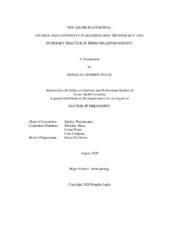| dc.description.abstract | This dissertation provides a preliminary report on the discovery of a Third Dynasty boat-burial from Abusir South (ca. 2544 BCE), and reevaluates a corpus of 70 Egyptian boats and boat-burials from the third millennium, demonstrating dramatic changes in both funerary practice and nautical technology. The Abusir Boat was excavated between 2015-2016 by the Czech Institute of Egyptology and the Institute of Nautical Archaeology. It is the only known boat-burial dated to Egypt’s Third Dynasty, and the only ancient Egyptian hull recorded with its lacing and wading intact. The 17-meter long funerary barque is a social and technological missing link that ties Khufu's Fourth Dynasty royal ship to the First Dynasty boat-burials from Abydos, Saqqara, Helwan and Abu Rawash.
The first part of this dissertation reevaluates the known corpus of Early Dynastic and Old Kingdom boat-graves. Prior scholarship has frequently assumed chronological continuity in the purpose and meaning of boat-burials and has focused on assigning interpretations based on later textual and iconographic sources. This dissertation challenges these assumptions. Focusing on the archaeological remains, it proposes a new typology for boat-graves, and identifies previously unrecognized patterns in the form, structure, associations, and distribution of boat-burials. These patterns can be linked to an ongoing status race between Egypt’s elites and royalty. Significantly, this dissertation demonstrates that changes in the form and distribution of boat-burials correspond to the wider social patterns proposed in the punctuated equilibrium theory of Egyptian history.
The second part of this dissertation analyzes the development of Egyptian nautical technology. The evidence from the Abusir Boat requires us to re-conceptualize how early Egyptian watercraft were built. This dissertation defines a tradition of “Early Nilotic Laced Construction” and disproves established hypotheses about the construction of Early Dynastic boats. Significantly, while the techniques used to construct the Abusir Boat link it to Early Dynastic boat-building traditions, its overall philosophy of construction is similar to Khufu's royal ship, bridging the immense technological gap between the First and Fourth Dynasty. While nautical technology underwent dramatic technological and philosophical changes following the Old Kingdom, this dissertation reveals how boatwrights innovated through the adaptation and repurposing of older techniques. | en |


